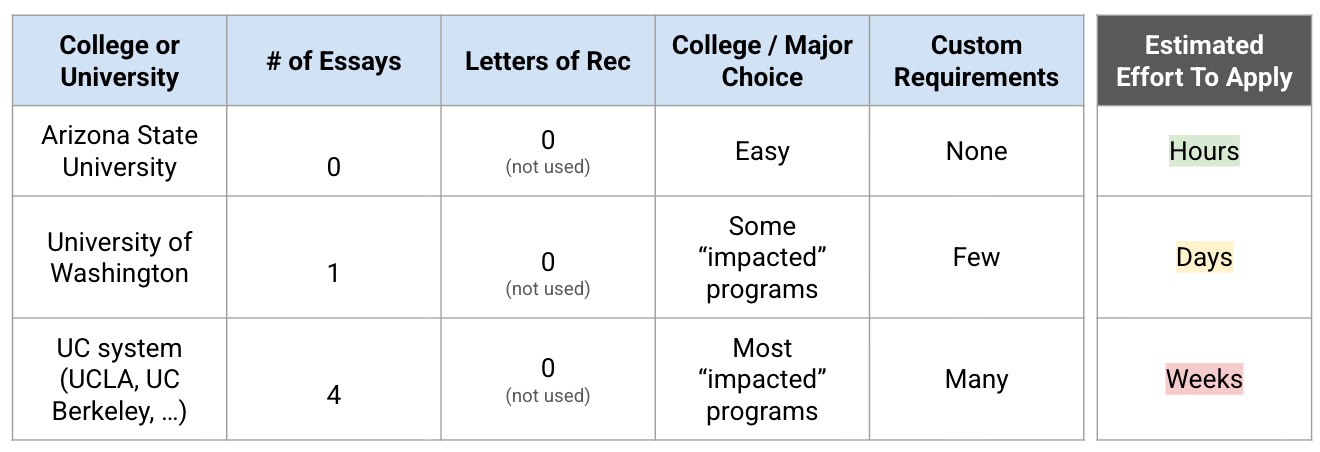Level of Effort
Before you pick deadlines and finalise your college list, use this three-tier guide to estimate the effort required to submit your applications.
How much work is a college’s application?
Your time (and patience) is finite. And requirements vary wildly across colleges and universities.
Knowing the workload helps you prioritise deadlines, and avoid last-minute surprises (e.g. honours apps, portfolios, letters of recommendation, etc…).
Knowing the workload also helps you build your sequence.
Submit “Easy” apps first to bank early admits. Many colleges, especially large public universities, give you answers back in the first few weeks after you’ve submitted your app. Everyone likes a YES answer, and building early wins helps with momentum and motivation.
Progress also feels different when effort equals a finished application and not just a portion of an app. If you start with 10 schools, spending a few hours to submit 3 complete apps beats spending the same time on one crucial essay and ending the day with all 10 apps remaining.
Then, schedule “Normal” apps next.
Last, reserve dedicated blocks for “Difficult”, with earlier internal deadlines so that you’re continuing to make steady progress along the way.
Bucket A - “Easy” (single app, minimal writing, no SAT/ACT)
Schools in this category do not require any essays - not even the Common App essay (personal statement). They are test-optional, or in some cases test-blind. They don’t require letters of recommendation. And admission decisions are generally formula-driven, e.g. GPA + college prep courses = admit.
You can complete and submit these apps very quickly, usually in hours.
And, almost all schools in this category use the Common App, which saves you even more time. With the Common App you only have to fill out your personal information once, and then it is sent to all schools.
Examples:
Arizona State University. No personal essay; no rec letters required; test-optional.
University of Montana. No essay; no LORs required; test-optional (scores may be used for placement).
Bucket B - “Normal” (one essay, sometimes a bit of extra writing, no SAT/ACT)
Plan on writing one strong personal essay, the Common App essay (personal statement). And, occasionally, a short-answer question or two for school-specific responses about major choice or activities.
Letters of recommendation requirements vary, but if you’ve secured just one from a core subject teacher (English, math, science, social studies) you’ll usually be golden.
And colleges and universities in this bucket are all test-optional, or test-blind.
Examples:
University of Washington. Required personal statement; no letters of recommendation accepted.
University of Oregon. Personal essay required; test-optional; letters generally not required for baseline admission (honors adds writing).
Bucket C - “Difficult” (custom rules, multiple essays, special policies)
Colleges in this bucket are - quite unfortunately - the drivers of most of the info about admissions you read on social media and the internet. They’re complicated!
You may need to: (a) calculate/understand a custom high-school GPA formula to know if you’re a competitive applicant, (b) pick specific colleges and/or majors, and understand how these choices impact your admission chances, (c) write multiple essays, (d) track major-specific add-on questions and info, (e) decide on an admission plan such as Early Decision vs Early Action vs Regular Decision, and more…
Testing policies vary by university, but you’re more likely to encounter colleges that require standardised tests.
Expect a lot more pre-work to gauge competitiveness (e.g., UC GPA, UT rank context) and all the hoops you’ll need to jump through just to be able to fully submit your application.
Examples:
University of California (all campuses). UC application (not Common App); 4 of 8 Personal Insight Questions (max 350 words each); no LORs at time of application (some campuses may later request); test-free (SAT/ACT not considered). UC-specific GPA rules (10–11th “a-g,” weighted/capped), UC-specific high-school course requirements (called “A-G requirements”).
University of Michigan. Common App personal essay plus two UM supplements; one teacher evaluation required; choose a U-M school/college (LSA, Engineering, etc.) on the app; some colleges have extra steps. Test-optional. Also, different admission plans - e.g. Early Decision vs Early Action vs Regular Decision.
University of Texas at Austin. Main essay + several short answers; choose first/second-choice majors; SAT/ACT required starting Fall 2025 entry. LORs optional; portfolios/auditions for some majors.
Honours Colleges and Special Programs
If you’re applying to honours, you need to treat it like a separate “normal/difficult” mini-app. There are often extra essays, required letters of recommendation, and earlier deadlines.
As an example, the Barrett honours college at Arizona State University requires two letters of recommendation and essays even though the general ASU app requires neither.
And arts/architecture/music and sometimes even business programs may require portfolios or auditions.
A Quick Triage Checklist To Gauge Level of Effort
App platform & baseline writing: Common App vs custom application platform; # of required essays.
Testing policy: Test-required, test-optional, or test-free this cycle. (Policies change, so confirm on their website.)
Recommendations: Required/optional/not accepted? How many? Who? 
College/major choice on app: Y/N; any extra steps (e.g., Michigan college selection, UT major choice).  
Extras: Honors deadlines, portfolios, auditions, custom application pre-reqs, custom GPA calculations, high-school course requirements (e.g. UC A-G requirements).


